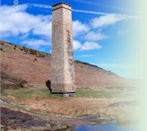
Industrial Wales - Monmouthshire's Eastern Valley
The Blorenge, Pwlldu, Garndyrys and Tyla
following Hills Tramroad to Llanfoist
Search the site here

|
Industrial Wales - Monmouthshire's Eastern Valley
The Blorenge, Pwlldu, Garndyrys and Tyla
following Hills Tramroad to Llanfoist
|
Search the site here
|
 Ironworks tuyere at Rifle Green |
 Balls Pond, Pen-fford-goch |
 Coal tramroad formation |
 Coal tramroad formation |
 Keepers Cottage, Pen-fford-goch |
 Tuyeres at the Upper Brickworks |
 Tuyeres at the Upper Brickworks |
||
 Osborne Cottage |
 Osborne Cottage |
 Osborne Cottage |
 Tips behind Osborne Cottage |
 Blorenge radio station |
 Blorenge radio station |
 Blorenge radio station |
 Blorenge radio station |
 Blorenge radio station hut |
 Blorenge radio station |
 Cefn-y-Galchen Colliery |
 Cefn-y-Galchen Colliery |
 Cefn-y-Galchen Colliery |
 Cefn-y-Galchen farm |
 Cefn-y-Galchen Colliery |
 Cefn-y-Galchen Colliery |
 Cefn-y-Galchen Colliery |
 Cefn-y-Galchen Colliery |
 Dyne-Steel incline from Tyla |
 Tips at foot of Dyne-Steel incline |
 Buildings from the opencast mining |
 Buildings from the opencast mining |
 Balance pond for Pwlldu Quarry |
 Leat from Pwlldu to Garnddyrys |
||
 Leat from Keepers Pond |
 Leat from Keepers Pond |
 Leat from Keepers Pond |
 The ruins of Pen Rhiw Ifor |
 The ruins of Pen Rhiw Ifor |
 The ruins of Pen Rhiw Ifor |
 Smallholding on The Tumble |
 Tumble blacksmiths |
 Tumble blacksmiths |
 Tumble blacksmiths |
 Tumble blacksmiths |
 Hills Tramroad incline top |
 Tramroad incline top foundations |
 Inclines from the Blorenge |
|
 Top incline to Llanfoist |
 Top incline to Llanfoist |
 Llanfoist middle incline subway |
 Llanfoist lower incline subway |